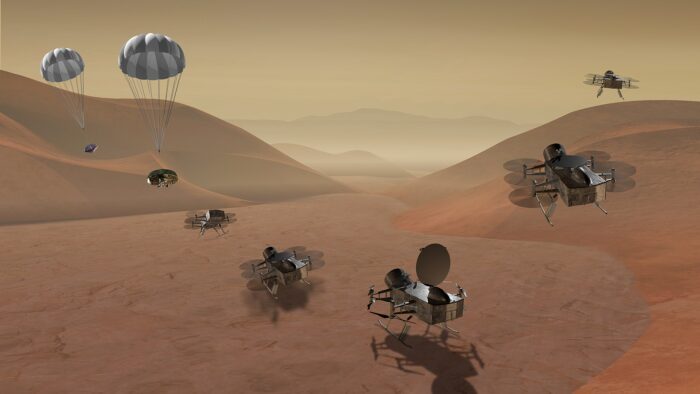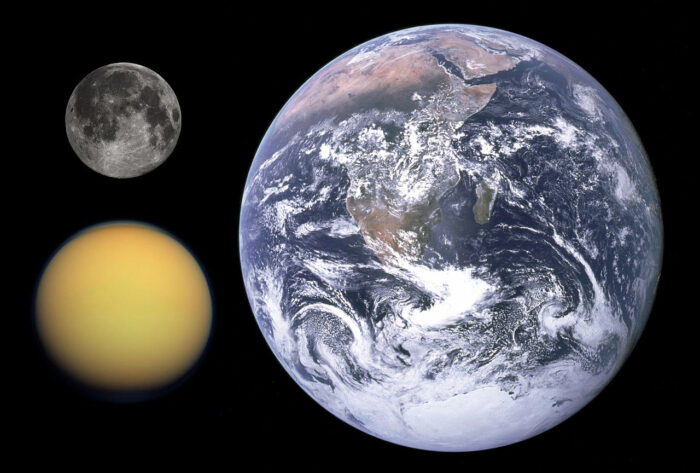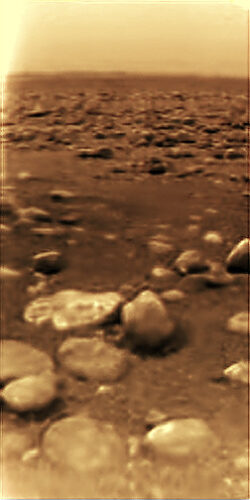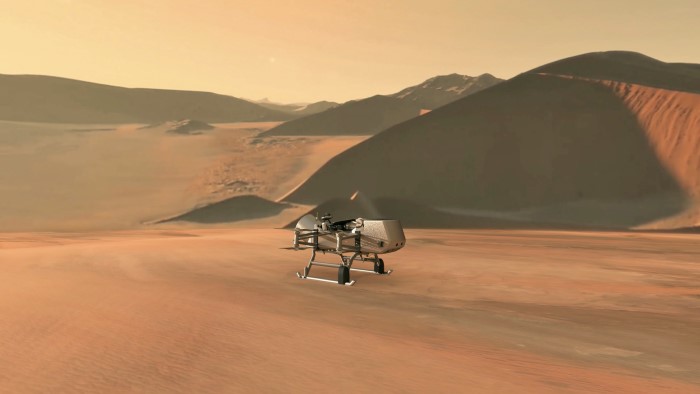In 2027, NASA will launch a probe named Dragonfly.
In 2034, Dragonfly will arrive at its destination, Saturn's largest moon, Titan.
If you're keeping score at home, that's twelve years from now. But nothing gets planned ahead of time like a space mission! And a new study has taken time to describe the setting that awaits Dragonfly when it arrives on this remarkable new world.
According to Lea Bonnefoy, a researcher at Cornell University, “Dragonfly will land in an equatorial, dry region of Titan—a frigid, thick-atmosphere, hydrocarbon world. It rains liquid methane sometimes, but it is more like a desert on Earth—where you have dunes, some little mountains and an impact crater."
A cold, alien desert that rains methane? Wow! Let's learn more!
What is Dragonfly?

Concept art of different stages of Dragonfly's landing. (NASA/Wikimedia Commons)
And let's start our learning with some more about this special probe.
Like its namesake, this Dragonfly can indeed fly. It is basically going to be like a mini-helicopter/drone (though it is much bigger than the rotorcraft currently on Mars, Ingenuity). It will be about the size of a small car and weigh about 450 kilograms (992 pounds). It will have eight rotors that are each about one metre (3.3 ft) across.
These will allow it to zoom fairly swiftly around the world—its top speed should be about 36 km/h (22 mph), which is similar to the speed limit of a residential neighbourhood. So a pleasant Sunday drive on a moon worlds away.
Why Titan?

Composite image showing the relative sizes of the Moon, Titan, and Earth. (Wikimedia Commons)
And that world is a really cool one. Titan may be a moon, but it is much closer to a planet than our own Moon. For starters, it is twice the size of the Moon and larger than the planet Mercury. And unlike both of those rocky worlds, it is a geologically active place.
It has a mainly nitrogen atmosphere that is four times as dense as Earth's. It has winds and rain. Rivers and lakes. It even has seasons! These factors make it an exceptionally fascinating place to study. Many scientists believe that it has many similarities to early Earth.
One of the biggest differences, though, is the temperature. The average temperature on Titan is around 94 K, −179 °C, −290 °F (K is Kelvin, a unit of temperature measurement commonly used in space and on other worlds—you can read more about it here). This extreme cold means that all of those rivers and lakes are made not of water, but of liquid methane and ethane. These are elements that really only exist as gases on Earth. In fact, methane is considered one of the most potent greenhouse gases leading to climate change.
What will Dragonfly find?

A shot of the surface of Titan, taken by the Hyugens probe in January, 2005. (NASA/Wikimedia Commons)
So far, nearly everything that we know about Titan has come from probes that have orbited above its surface. This has included the Pioneer and Voyager probe from the last century, and the much more recent Cassini probe, which only ended its mission in 2017 by crashing into Saturn's atmosphere.
Titan was a big part of Cassini's mission. It used radar to penetrate the moon's dense atmosphere and give us a pretty detailed map of its surface. It also landed a probe there, called Hyugens. Hyugens landed on Titan on January 14, 2005. Once there, it transmitted information for about 90 minutes and then stopped functioning.
It was all pretty cool. Hyugens showed us valleys and detailed on the surface that Cassini's radar could not. But technology has come a long way since then. After all, Cassini was launched in 1997, thirty years before Dragonfly's proposed launch.
The advanced tech that will be on board Dragonfly should help it survive for much longer than an hour and a half. The hope is that it will be able to take longer and longer flights and genuinely explore much of Titan's expanse. And that advanced tech will also deliver far clearer images and video (just think of how powerful the average smartphone camera is).
"The radar images we have of Titan through Cassini have a best-resolution of about 300 meters per pixel," Bonnefoy said in a press release. "[That is] about the size of a football field and we have only seen less than 10% of the surface at that scale. This means there are probably a lot of small rivers and landscapes that we couldn’t see.”
Whatever is there, Dragonfly is going to show it with a level of detail that will be miles ahead of anything we've seen before.
Until then, take a look at this animation of what the probe's landing might look like.
 An illustration of what it might look like for Dragonfly as it lands on Titan. (NASA/JHU-APL)
An illustration of what it might look like for Dragonfly as it lands on Titan. (NASA/JHU-APL)









